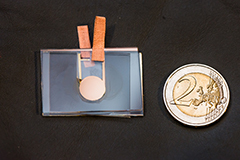The most efficient thermoelectric ionistor is charged even from solar heat
 In the laboratory of organic electronics at Linköping University (Sweden) , an ionistor was developed that super-efficiently converts heat into electricity. It can be charged from the Sun or collect thermal energy from other sources, for example, from some production process.
In the laboratory of organic electronics at Linköping University (Sweden) , an ionistor was developed that super-efficiently converts heat into electricity. It can be charged from the Sun or collect thermal energy from other sources, for example, from some production process.Ionistor does not contain expensive or harmful materials in any significant quantities and is fully suitable for manufacturing on an industrial scale on existing production lines. Inventors hope that a new type of thermoelectric devices will find wide application, so that we will no longer be aimlessly dissipating heat into the atmosphere.
An ionistor is a capacitor with an organic or inorganic electrolyte, the plates of which serve as a double electrical layer at the interface between the electrolyte and the electrode. The thickness of the electric double layer is extremely small, and the area of porous materials of the plates is very large, so that the stored energy is higher compared to conventional capacitors.
When creating a new ionistor, scientists used a thermodynamic effect ( the Soret effect ) - the occurrence of voltage between contacts with different temperatures.
')

For many years in the laboratory have experimented with different types of electrolytes from ions and conductive polymers. Positively charged ions are small and fast, and negatively charged polymer molecules are relatively bulky and heavy. When a temperature difference occurs, the cations move to the cold electrode quickly, and the anions remain in place. The charge accumulates in a layer of carbon nanotubes.


The researchers managed to pick up electrolyte thousands of times more efficiently than all existing ionistors on the thermoelectric effect. The electrolyte is made on the basis of polyethylene glycol (PEO) with the addition of NaOH (C (NaOH) = 0.75mM). One ionistor electrode is made of gold, the second - from carbon nanotubes.
The inventors admit that they themselves do not understand why their thermoelectric ionistor is 2500 times more efficient than all existing ones.

The scientific work "Ionic Thermoelectric Supercapacitor" was published in the journal Energy & Environmental Science ( pdf ).
Source: https://habr.com/ru/post/391635/
All Articles